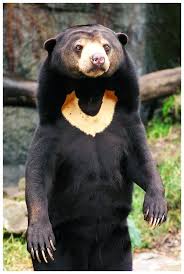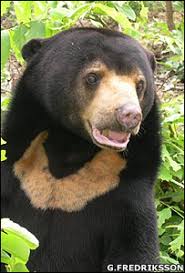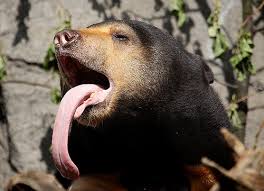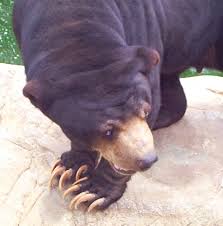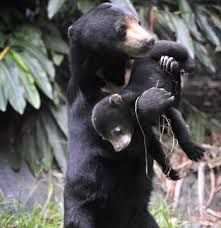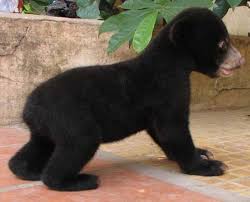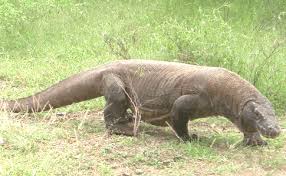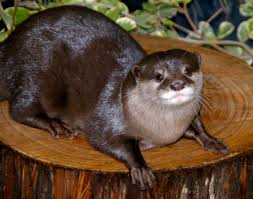***All opinions expressed on this blog are mine exclusively and are not endorsed by the Kansas City Zoo.
 |
| POLAR BEAR |
Polar Bear-
Ursus maritimus is the worlds largest land carnivore. Male polar bears can weigh up to 1300lbs, but females are only half that size.
 |
| Polar Bear Range |
The polar bear lives exclusively in the Artic (which means with bear.) Polar Bears do not live in the Antartic (without bear). That means that polar bears and penguins could never be friends, because they live on opposite poles. (besides polar bears would eat a blubbery penguin in a second if they could catch them.)
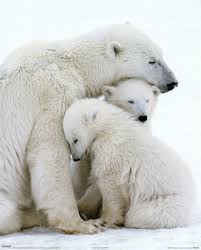 |
| Mother With Two Cubs |
Polar bears are solitary in the wild, they only come together to mate, or occasionally when they are isolated in small areas during summer months when the ice has melted. The other time when they spend time in groups is a mother with her cubs. The mother ususally has one - three cubs. Singletons are becoming more and more common as food/ice becomes more scarce. The cubs are born in November in a den that the mother scrapes out of the snow and ice. The cubs weigh less than 2 pounds at birth, but they grow fast on the mothers rich milk. In February - April they all leave the den. Mom finally gets to eat again after 3-5 months of fasting and feeding her young. Unfortunately she only has a few short months to rebuild her fat stores before the sea ice dissappears and she has to fast again.
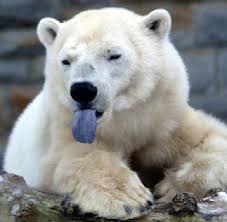 |
| The black tongue and nose match all his skin under his fur |
The polar bear is well adapted to life in the artic. They have four inches of blubber covered by black skin which absorbs any available sunlight. They also have hollow guard hairs that appear white, but are actually clear. The guard hairs do not conduct sunlight, but they trap warm air radiating off the bear and help conserve energy. Polar bears are far more likely to overheat than they are to freeze.
 |
| A dinner plate covered in tire tread |
They are also well adapted to walking across ice. The feet of a male polar bear can be 12" in diameter (about the size of a dinner plate). The bottoms of their paw have black pads which are covered with papillae, tiny bumps that act like the tread on a snow tire. They also have thick fur that gives them excellent traction. This makes it possible for them to creep along the ice to sneak up on a ringed seal. Two inch long claws top off these formidable paws and can be used for traction, to dig in thick ice, and to kill or disable prey. The broad paws also act like paddles to help the "sea bear" swim through artic waters.
 |
| The nose knows |
The polar bears eye site is good, and his hearing is equal to a humans, but his nose puts a humans nose, and even a dogs in the...
dust snow. The polar bear can smell a seal from a mile away under three feet of ice. They can smell a dead whale or wallrus on the ice from 20 miles away. ( Manhattan Island is only 13.4 miles long!) Their nose is attached to a long narrow head and neck that's good for swooping into seal's breathing holes, and makes them an aerodynamic swimmer.
 |
| Ice Bears |
Polar bears depend on thick pack ice to hunt. The thick blubber and fur that keeps them warm, also makes them overheat when they try to chase prey over land for long distances. Even the sea bear can't swim fast enough or deep enough to catch a seal or fish in the water. The only way for them to get a meal is to hunt from the ice.
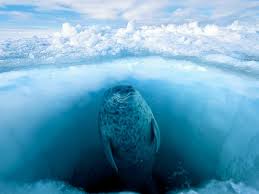 |
| Ringed Seal Just Under the Ice |
Seals spend the icy months swimming from air hole to air hole in the pack ice. When they have to haul out, they dig caves and tunnels in the ice. They are never far from a hole in the ice that they can slip into and disappear. On land they're essentially a darling little tub of lard with flippers, but in the water they're like Michael Phelps.
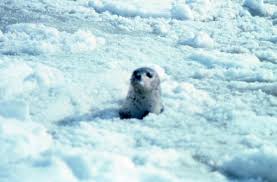 |
| Seal Comes Up For Air |
 |
| Bear Waits Patiently for Seal to Surface |
During the summer months when there is no ice, the bears can't hunt for seals. They have to be fat enough to survive until the ice returns. The ice has started to form later and melt earlier every year. This means that polar bears have less time to feed and more and more bears are dying of starvation. Mother polar bears are having more and more single births due to food shortages.
for more information on Polar Bears, check out the
Polar Bears International Web Site.
Here's the video I took of our polar bear, Nikita at the Kansas City Zoo. He's a four year old bundle of energy, who already weighs 830lbs. He'll keep growing for another two years or more. He loves to swim up to the visitors at the window and push off.




















